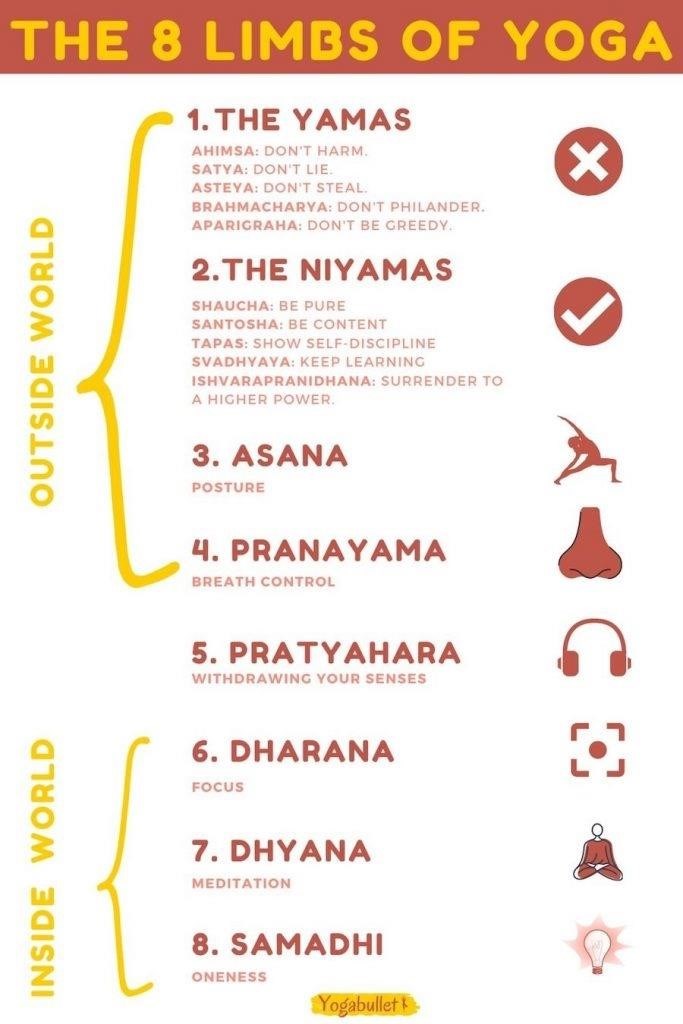The Eight Limbs of Yoga⁚ A Comprehensive Guide
Explore the eight limbs of yoga‚ a path to self-awareness and enlightenment detailed in Patanjali’s Yoga Sutras. These limbs—Yamas‚ Niyamas‚ Asana‚ Pranayama‚ Pratyahara‚ Dharana‚ Dhyana‚ and Samadhi—offer a holistic framework for a meaningful life. Discover how each limb contributes to inner peace and spiritual growth‚ providing a comprehensive guide to this ancient practice. Many resources‚ including PDFs‚ detail this transformative journey.
The eight limbs of yoga‚ as outlined in Patanjali’s Yoga Sutras‚ offer a comprehensive path to self-realization and liberation‚ extending far beyond the physical postures often associated with modern yoga. This ancient system presents a holistic approach to well-being‚ encompassing ethical conduct‚ self-discipline‚ and meditative practices. Forget the misconception that yoga is solely about asanas; it’s a journey of self-discovery‚ integrating physical‚ mental‚ and spiritual dimensions. Numerous resources‚ including readily available PDFs‚ delve into each limb‚ providing detailed explanations and guided practices. Understanding these eight limbs unlocks a deeper appreciation for the transformative power of yoga‚ offering a roadmap to a more balanced and fulfilling life. The eight limbs are not merely steps to be followed sequentially; they are interconnected aspects of a unified practice‚ working synergistically to promote holistic well-being. Embark on this journey of self-exploration‚ and discover the profound wisdom embedded within this ancient tradition.
Yamas⁚ Ethical Restraints
The Yamas‚ the first limb of Patanjali’s eightfold path‚ establish a foundation of ethical conduct‚ guiding us towards virtuous living. These principles‚ often described as “restraints‚” aren’t about rigid rules but rather about cultivating inner harmony through mindful actions. Ahimsa (non-violence)‚ Satya (truthfulness)‚ Asteya (non-stealing)‚ Brahmacharya (continence/wise use of energy)‚ and Aparigraha (non-attachment) form the core of the Yamas. Ahimsa extends beyond physical harm to encompass thoughts‚ words‚ and actions. Satya encourages honesty and integrity in all interactions. Asteya promotes respect for others’ possessions and resources. Brahmacharya emphasizes mindful energy management‚ and Aparigraha encourages letting go of material attachments. Exploring these principles fosters self-awareness and ethical decision-making. Many PDF resources dedicated to the eight limbs of yoga offer detailed explanations of the Yamas‚ providing practical guidance on integrating these ethical restraints into daily life. Mastering the Yamas lays the groundwork for deeper spiritual practice.
Niyamas⁚ Personal Observances
Following the ethical restraints of the Yamas‚ the Niyamas delve into personal observances that cultivate inner growth and self-discipline. These five principles—Saucha (cleanliness)‚ Santosha (contentment)‚ Tapas (discipline)‚ Svadhyaya (self-study)‚ and Ishvara Pranidhana (surrender to a higher power)—focus on internal transformation. Saucha encompasses physical‚ mental‚ and spiritual purity‚ encouraging mindful habits that promote well-being. Santosha cultivates gratitude and acceptance‚ fostering inner peace amidst life’s challenges. Tapas involves self-discipline and dedication‚ pushing boundaries to achieve personal growth. Svadhyaya encourages self-reflection‚ introspection‚ and the pursuit of knowledge‚ often through study of sacred texts or self-inquiry. Finally‚ Ishvara Pranidhana involves surrendering to something greater than oneself‚ fostering a sense of trust and faith. Many online resources‚ including PDFs‚ provide further exploration of the Niyamas‚ offering practical exercises and guidance on incorporating these personal observances into daily life. By practicing the Niyamas‚ individuals cultivate inner strength‚ resilience‚ and a deeper connection to their true selves. They are essential for a balanced and fulfilling life.

Asana⁚ Physical Postures
Asana‚ the third limb of yoga‚ focuses on physical postures. Moving beyond mere physical exercise‚ asanas aim to cultivate strength‚ flexibility‚ balance‚ and body awareness; The practice of asanas isn’t simply about achieving perfect poses; it’s about cultivating a mindful connection with the body. Each posture presents an opportunity for self-observation‚ allowing practitioners to notice sensations‚ emotions‚ and mental states arising during the practice. This mindful engagement fosters a deeper understanding of the body’s capabilities and limitations. Various styles of yoga offer a wide range of asanas‚ catering to different levels of experience and physical abilities. From gentle stretches to challenging inversions‚ asanas provide a path toward physical well-being and mental clarity. Numerous resources‚ including PDFs‚ offer detailed instructions and modifications for different asanas‚ ensuring accessibility for individuals of all levels. Beyond the physical benefits‚ asanas prepare the body for deeper meditative practices‚ creating a stable foundation for the subsequent limbs of yoga. The sustained practice of asanas cultivates a sense of presence and embodiment‚ fostering a deeper connection between mind and body;
Pranayama⁚ Breath Control Techniques
Pranayama‚ the fourth limb of yoga‚ delves into the conscious regulation of breath. More than just breathing exercises‚ pranayama techniques cultivate a profound connection between the breath and the mind. By consciously controlling the rhythm‚ depth‚ and flow of breath‚ practitioners can influence physiological responses‚ calming the nervous system and sharpening mental focus. Various pranayama techniques exist‚ each offering unique benefits. Some techniques‚ like Ujjayi breath‚ promote relaxation and inner stillness‚ while others‚ like Kapalabhati‚ stimulate energy and enhance clarity. Many resources‚ including readily available PDFs‚ provide detailed instructions and visualizations to guide practitioners through different pranayama techniques. The practice of pranayama requires patience and consistent effort. With dedicated practice‚ practitioners develop greater control over their breath‚ leading to increased self-awareness and emotional regulation. Pranayama serves as a bridge between the physical postures of asana and the deeper meditative practices that follow‚ preparing the mind and body for introspection and inner exploration. The subtle energies cultivated through pranayama enhance the effectiveness of subsequent limbs‚ paving the path toward a more balanced and harmonious state of being.
Pratyahara⁚ Sensory Withdrawal
Pratyahara‚ the fifth limb of yoga‚ signifies the inward turning of consciousness‚ a deliberate withdrawal from the external world’s incessant stimulation. It’s not about physical isolation but a conscious redirection of attention from external sensory inputs to internal awareness. This practice involves quieting the senses—sight‚ sound‚ smell‚ taste‚ and touch—to cultivate inner peace and focus. By gently shifting attention inward‚ practitioners begin to observe the incessant chatter of the mind‚ becoming more aware of their thoughts and emotions without judgment. This process of sensory withdrawal is not a suppression of sensory experience‚ but a conscious choice to prioritize inner observation. Various techniques can aid in cultivating pratyahara‚ including focusing on a single point‚ such as a candle flame‚ engaging in breath awareness‚ or practicing mindfulness meditation. Many resources‚ including downloadable PDFs‚ explore these techniques in detail‚ offering step-by-step instructions and guidance. The ability to withdraw from external distractions is crucial for deeper meditative practices. As practitioners refine their capacity for pratyahara‚ they develop a stronger sense of self and a heightened ability to observe the mind’s patterns and tendencies‚ preparing the ground for the concentration and focus cultivated in the following limbs.
Dharana⁚ Concentration and Focus
Dharana‚ the sixth limb in the eight-limbed path of yoga‚ represents the cultivation of unwavering concentration and mental focus. Building upon the foundation of Pratyahara (sensory withdrawal)‚ Dharana involves directing the mind’s attention towards a single point of focus‚ thereby strengthening the mind’s ability to resist distractions. This focused attention can be directed towards a mantra‚ a visual object‚ a specific breath pattern‚ or even a particular sensation within the body. The practice of Dharana requires patience and persistence‚ as the mind naturally wanders. The goal is not to eliminate distractions entirely but to gently redirect the attention back to the chosen point of focus each time the mind wanders. This process strengthens the mind’s capacity for sustained concentration‚ improving mental clarity‚ focus‚ and attention span. Many resources‚ including numerous PDFs readily available online‚ provide detailed instructions and guidance on various Dharana techniques; These resources often offer practical exercises to develop concentration‚ such as focusing on the breath‚ visualizing a specific image‚ or repeating a mantra. Through consistent practice‚ Dharana paves the way for deeper meditative states‚ preparing the practitioner for the more profound absorption of Dhyana (meditation).

Dhyana⁚ Meditation and Contemplation
Dhyana‚ the seventh limb of yoga‚ signifies the state of sustained‚ effortless‚ and unwavering concentration achieved through dedicated practice. It represents a profound level of meditative absorption‚ where the mind is still and focused‚ free from the incessant chatter of thoughts and distractions. Building upon the focused concentration of Dharana‚ Dhyana transcends mere concentration into a state of effortless awareness. In this meditative state‚ the practitioner experiences a deep sense of peace‚ tranquility‚ and connection with the inner self. The experience of Dhyana varies from person to person‚ with some describing it as a state of blissful awareness‚ while others report a profound sense of clarity and insight. Many resources‚ including numerous online PDFs‚ offer guidance on various meditative techniques that can facilitate the experience of Dhyana. These techniques often involve focusing on the breath‚ visualizing a specific image‚ repeating a mantra‚ or simply observing thoughts and emotions without judgment. While the attainment of Dhyana may take time and consistent practice‚ the benefits are profound‚ leading to increased self-awareness‚ emotional regulation‚ and a deeper understanding of one’s inner self. This deep meditative state lays the foundation for the final limb‚ Samadhi.
Samadhi⁚ Absorption and Enlightenment
Samadhi‚ the eighth and final limb of yoga‚ represents the culmination of the yogic path—a state of complete absorption‚ union‚ and enlightenment. It’s the ultimate goal‚ a transcendent experience beyond the limitations of the individual self. Building upon the profound meditative state of Dhyana‚ Samadhi signifies a profound merging of the individual consciousness with the universal consciousness‚ a state of oneness with the divine. This isn’t merely a mental state but a profound transformation of being‚ characterized by profound peace‚ bliss‚ and an unshakeable sense of unity. The experience of Samadhi is often described as ineffable‚ beyond the capacity of words to fully capture. While many strive for this ultimate state‚ the path to Samadhi is a deeply personal journey‚ requiring years of dedicated practice and unwavering commitment to the other seven limbs. Various schools of yoga offer different perspectives on Samadhi‚ with some emphasizing the role of grace and surrender‚ while others focus on the importance of disciplined practice and self-knowledge. Numerous online resources‚ including downloadable PDFs‚ explore the different interpretations and pathways to Samadhi. Achieving this state is not a destination but a continuous unfolding‚ a deepening of awareness and connection that continues to evolve throughout one’s life. The journey itself is as significant as the destination‚ offering profound transformation at every stage.